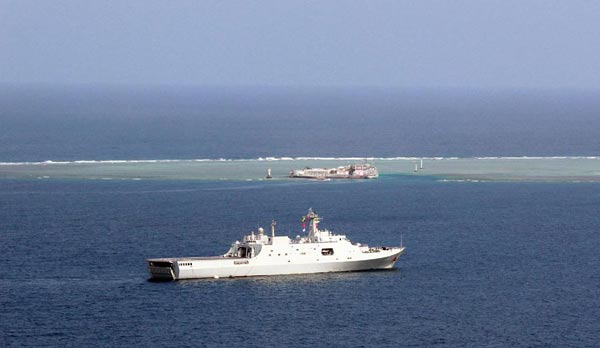 |
|
A formation of the Nanhai Fleet of China's Navy on Saturday finished a three-day patrol of the Nansha islands in the South China Sea. [Photo/Xinhua] |
The three-day Shangri-la Dialogue that starts on Friday is set to focus on the South China Sea, and no doubt the United States and some of its allies will grasp the opportunity to play up what it claims China's military expansion in the South China Sea.
However, it's the US that is militarizing the waters and should reflect on the potential risks.
The militarization of the South China Sea as a result of the US' military build-up and its frequent so-called freedom of navigation operations increases the chances of a dangerous collision. The growing risk of a possible collision raises questions about whether the existing international laws can regulate the conduct of relevant parties. If not, should China and US sign an Incident at Sea (INCSEA) Agreement to curtail dangerous encounters.
The 1982 United Nations Convention on the Law of the Sea classifies the sea into various jurisdictional zones with rights and duties. These serve as a benchmark for deciding on the lawfulness of the conduct of relevant parties. Consequently, the location of an incident at sea plays a key role in judging the lawfulness of any maritime activity.
The US has released a statement that accuses China of conducting "unsafe" interception of a US reconnaissance plane in "international airspace" over the South China Sea. But "international airspace" is a term which cannot be found anywhere in UNCLOS. Based on the US stance as reflected in its public statement and Navy Commander's Operational Handbook, the term "international space" refers to the airspace over the maritime areas beyond territorial waters, which may include airspace over both the exclusive economic zones and the high seas. This is typical of the US, as it sets its own understanding of the international law of the sea above and beyond the shared international understanding.
Notwithstanding the fact that the US is not a party to the Convention and habitually chooses some articles of it that are to its advantage as reflecting customary international law, this US-designed term does lead to serious conflict of understanding of law regarding the legal status of each maritime area and its associated airspace, in particular that of the EEZ and its airspace. While the international community aligned under the Convention takes an EEZ as a particular maritime zone governed by a specific legal regime with balanced rights and obligations between the user and coastal State, the US as a non-party insists that the freedom of navigation and overflights exercised within and beyond EEZs "must be qualitatively and quantitatively the same as the traditional high seas freedoms recognized by international law".
This leads to the possibility of operational confrontation at sea.
Another element that may have a bearing on the regulation of the US' reconnaissance activities is the rules of international law regarding un-alerted air encounters between military aircraft. Many of the relevant international rules originate from the 1944 Chicago Convention on International Civil Aviation, to which both China and US are both parties. The 1944 Chicago Convention includes Annex 2, entitled Rules of the Air, which recommends standards and best practice with regard to the interception of civilian aircrafts, but it does not apply to the interception of non-civilian aircraft.
One may also cite the China-US Memorandum of Understanding on Air and Maritime Encounters. Notwithstanding the non-binding force of the MOU, this also raises the question of who would be the judge to decide on the lawfulness of the parties involved in any incident. Either side should not be the judge of itself.
It is crystal-clear that it is the US military aircrafts that fly thousands of miles to the threshold of Chinese EEZs, to the airspace near Russia borders, and to other foreign EEZs, to conduct close-in reconnaissance, which serves as the root cause of the problem. Consequently, the best way to solve the problem is for the US to stop such close-in reconnaissance activities.
The author is a research fellow at the Collaborative Innovation Center of South China Sea Studies, affiliated to Nanjing University.

I’ve lived in China for quite a considerable time including my graduate school years, travelled and worked in a few cities and still choose my destination taking into consideration the density of smog or PM2.5 particulate matter in the region.